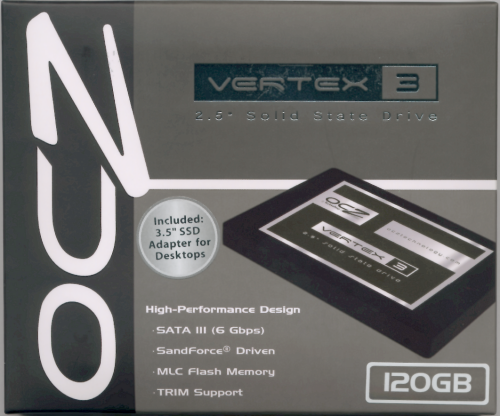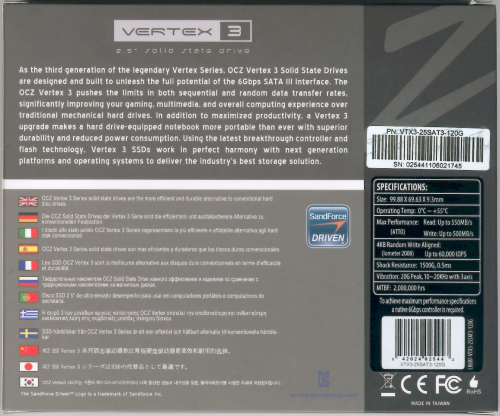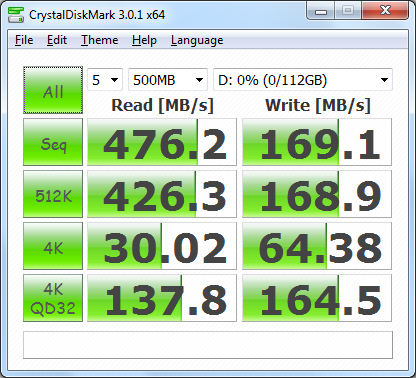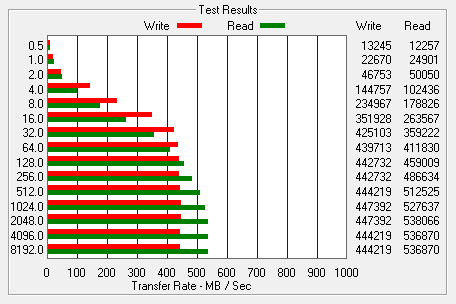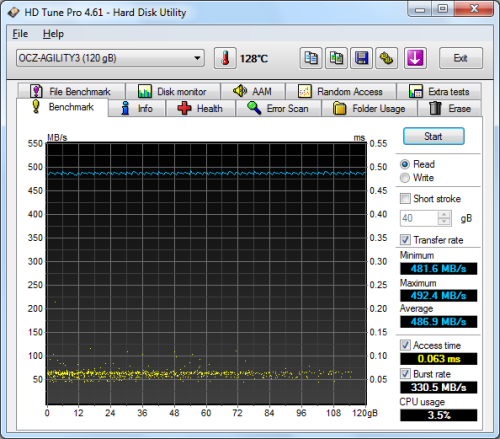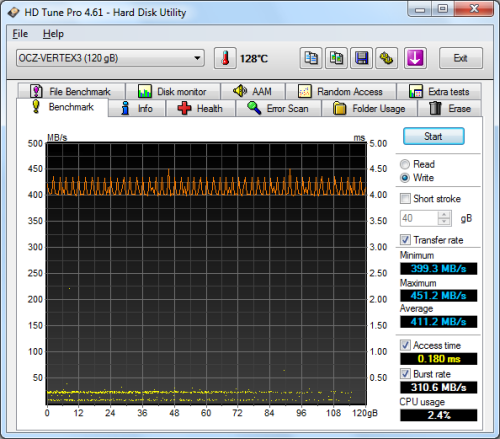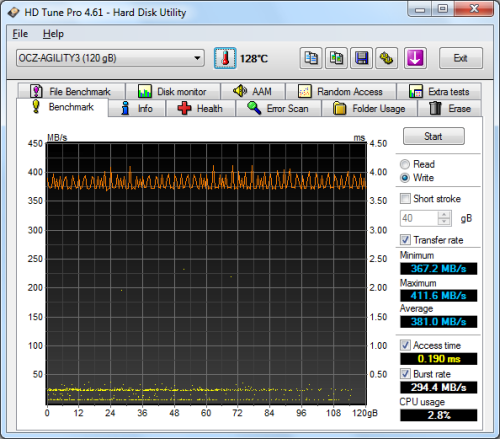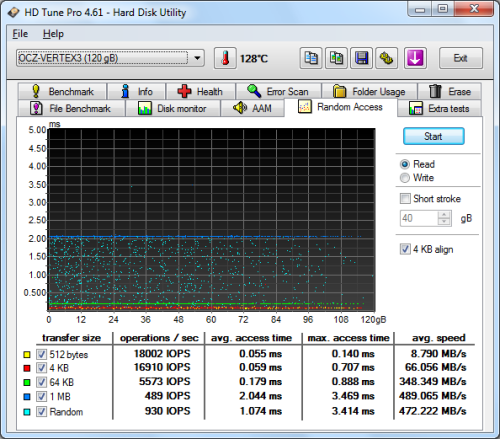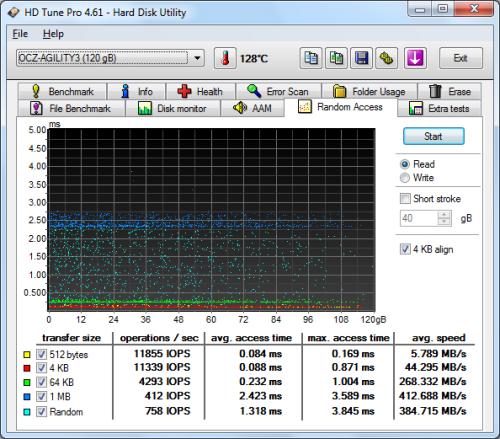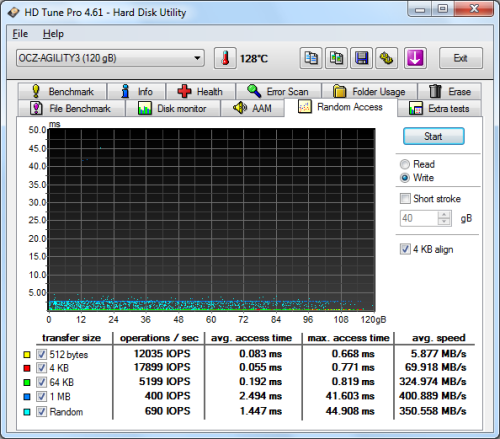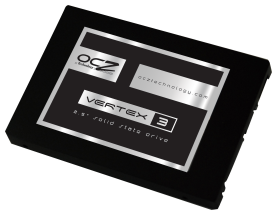

Model: OCZ Vertex 3 120GB Solid State Drive
Manufacturer: OCZ Technology
Provided By: OCZ Technology
OCZ Technology is no stranger to the computer industry. Founded by enthusiasts, for enthusiasts, the company entered the memory market in 2002. Determined to manufacture the very best memory for overclockers, OCZ quickly established itself as a leader in the industry by breaking speed barriers and maintaining a reputation of quality. Today, OCZ continues to innovate. Along with their line of enthusiast-oriented power supplies, the company offers a wide range of high-performance SSD solutions for the enterprise and consumer markets.

Over the last year or so, OCZ has introduced a number of new solid state drives. One of the latest additions to their consumer SSD lineup is the Vertex 3. Available in capacities ranging from 60GB up to 480GB, the Vertex 3 is powered by SandForce's SF-2281 processor and features a SATA 6GB/s interface as well as native TRIM support. OCZ's new SSD also uses 25nm synchronous MLC NAND flash to deliver up to 550MB/s read and 500MB/s write transfer rates and up to 60,000 4KB random write IOPS. To top it all off, the Vertex 3 ships with an adapter for use in both notebook and desktop PCs and is covered by a three-year warranty.
For this review, OCZ sent us the 120GB version of the Vertex 3. This SSD is capable of delivering up to 550 MB/s sequential read and 500 MB/s sequential write speeds as well as up to 20,000 random read and 60,000 random write IOPS.
| OCZ Vertex 3 120GB Solid State Drive | |||||||||||||||||||||||||||||||||||||||||||
General Specifications
Performance
Reliability
Power Consumption
Environmental
Dimensions and Weight
Other Features
|
Needless to say, this is only a taste of what the Vertex 3 has to offer. To give you an idea of what to expect, we'll take a closer look at OCZ's new SSD and then see how well it performs. Does the Vertex 3 have what it takes? Can it deliver the performance we've come to expect from OCZ? Keep reading as we find out.
The Vertex 3 comes in a small, black and gray box. Along with a picture of the drive, the front advertises many of its key features including its 120GB capacity, SATA 6Gbps interface, SandForce controller, MLC flash memory and TRIM support. The back of the box provides a bit more information, including the Vertex 3's specifications and a full list of features. Inside, you'll find the SSD, a 3.5" adapter bracket, mounting screws, installation guide and a sticker that says "My SSD Is Faster Than Your HDD."
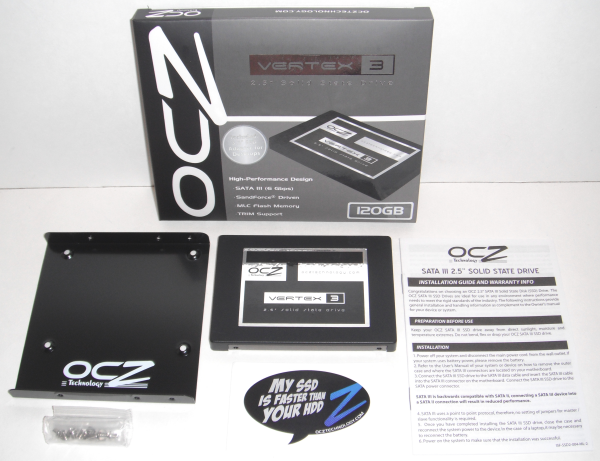
Physical Features:
The Vertex 3 looks very similar to OCZ's other 2.5" SSDs. The top of the outer casing is made out of plastic and has a matte black finish. There is also a large, silver and black sticker showing that the SSD is part of OCZ's Vertex 3 series. The bottom of the casing is made out of metal with a brushed metal finish. The stickers on the bottom show the drive's part number, capacity and serial number.

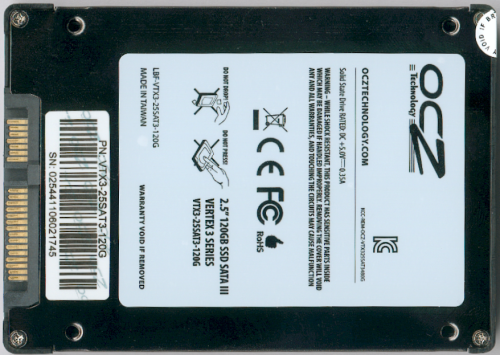
As I mentioned earlier, the Vertex 3 uses SandForce's SF-2281 controller chip. The SF-2281 can be found in a number of other SSD's including the ADATA S511, Corsair Force Series 3, OWC Mercury 6G and Patriot Wildfire as well as OCZ's own Agility 3 and Vertex 3 Max IOPS Series.
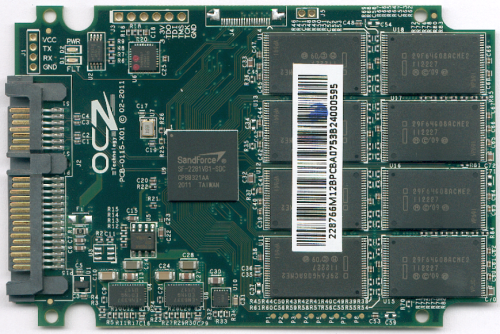

For the Vertex 3, OCZ opted to use Intel's 8GB 25nm 29F64G08ACME2 synchronous NAND flash chips. Looking at the pictures above, you can see that there are eight of these chips on either side of the PCB. If you do the math, you'll see that this equals 128GB and not the 120GB of storage the drive advertises. The SandForce controller uses this extra 7% (8GB) to maximize read and write performance and extend the endurance and overall reliability of the drive.
The test system used in this review was an HP 8200 Elite. The computer came equipped with an Intel Core i5-2400 CPU, 4GB of DDR3 1333MHz memory, Seagate Barracuda 7200.12 ST3250312AS 250GB SATA 6 Gb/s hard drive, NVIDIA Quadro FX580 512MB PCIe graphics card and an Intel 82579-LM gigabit network card. For the operating system, I installed a fresh copy of Windows 7 Enterprise.
To test the performance of the OCZ Agility 3, I ran a series of benchmarks using CrystalDiskMark 3.0.1, HD Tach RW 3.0.4.0, ATTO Disk Benchmark 2.46, AS SSD, HD Tune Pro 4.61 and Iometer. For comparison, I've also included test results from the OCZ Agility 3 and Plextor PX-128M2S.
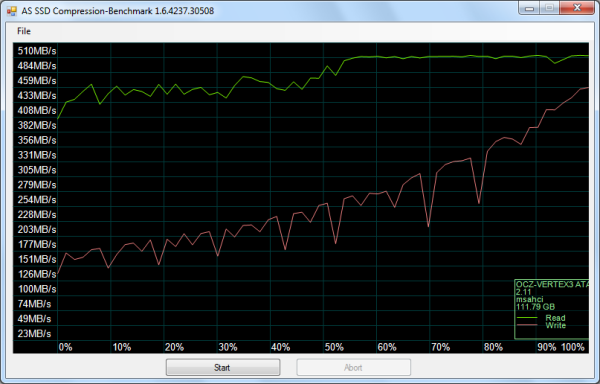
As I mentioned earlier, the Vertex 3 is based on SandForce's SF-2281 controller. Like other SandForce controllers, the SF-2281 features a technology called DuraWrite, which uses data compression to lower write amplification and extend the life of the drive by reducing the number of program-erase cycles. This data compression also plays a big part in the controller's performance. The more the data can be compressed, the faster an SSD like the Vertex 3 is able to read and write. Looking at the screenshot above, you can see that there is a considerable performance difference when writing incompressible (0%) and compressible (100%) data. However, thanks to the Vertex 3's synchronous NAND, its read speeds aren't affected nearly as much.
CrystalDiskMark 3.0:
First, I ran a few quick tests using CrystalDiskMark. This benchmark tool measures the performance of a storage device by testing its sequential read and write speeds as well as its random read and write speeds using blocks 512K and 4K in size.
According to OCZ, the 120GB Vertex 3 is capable of reading at 550MB/s and writing at 500MB/s when connected to a SATA 6 Gb/s port. While faster than the Agility 3, the drive's sequential read and write speeds came up a bit short of these numbers when using CrystalDiskMark's default (random) test data.
Like the Agility 3, the Vertex 3 performed much better when using highly compressible 0x00 (0 Fill) data. This time around, the drive was able to read at 495.4 MB/s and write at 460.2 MB/s.
HD Tach RW 3.0.4.0:
Next, I used HD Tach to test the Vertex 3's read, write and burst speeds as well as its seek times and CPU usage.
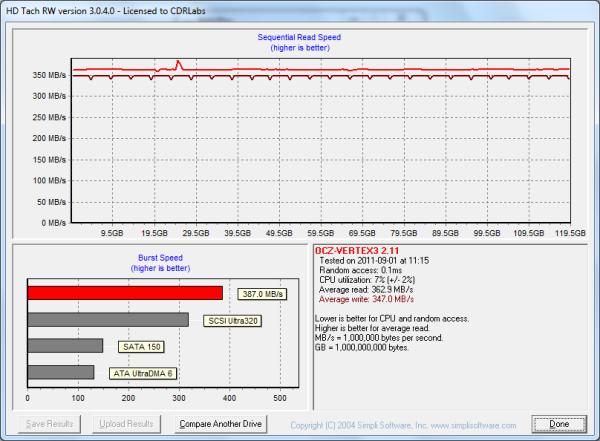
OCZ Vertex 3 120GB
Looking at the screenshot above, you can see that the Vertex 3 had average read and write speeds of 362.9 MB/s and 347.0 MB/s respectively, as well as a burst speed of 387.0 MB/s.
ATTO Disk Benchmark 2.46:
I also used ATTO Disk Benchmark to test the Vertex 3's sequential read and write speeds. The tests are run using blocks ranging in size from 0.5KB to 8192KB and the total length set to 256MB.
When tested with ATTO, the Vertex 3's read speeds topped out at about 558 MB/s and its write speeds at 481 MB/s.
AS SSD:
AS SSD is a relatively new benchmark designed specifically for solid state drives. The application contains five synthetic tests used to determine the sequential and random read and write performance of a drive. Take note that AS SSD uses incompressible data in its tests, which can have a major impact on the scores of SandForce-based drives like the Vertex 3.
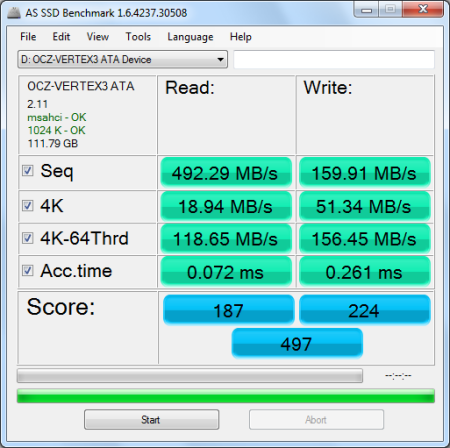
AS SSD also includes a copy benchmark. This test copies an ISO (two large files), program (many small files) and game (small and large files), returning the speed and duration of each.

HD Tune Pro 4.61:
Next, I ran a series of tests using HD Tune Pro. This hard disk utility measures a drive's performance by testing its sequential read and write speeds as well as its access time, burst rate and CPU usage. For this review, I'm also going to use it to benchmark the Vertex 3's random read and write speeds, random access times and the number of operations per second.
The Vertex 3 performed very well when benchmarked with HD Tune. The drive had average read and write speeds of 491.0 MB/s and 411.2 MB/s, respectively, and a burst rate of 333.2 MB/s when reading.
The Vertex 3 didn't disappoint when doing random reads and writes. When reading 4KB blocks, the drive reached 16910 IOPS and had an average speed of 66.056 MB/s. The Vertex 3 was even faster when writing, reaching 18227 IOPS with an average speed of 71.201 MB/s.
Iometer:
Lastly, I ran a series of tests using Iometer. This tool can be configured to benchmark a number of things. In this case, I used it to measure the Vertex 3's read and write speeds and the number of operations per second. The tests were run using both repeating and random bytes and a queue depth of 3.
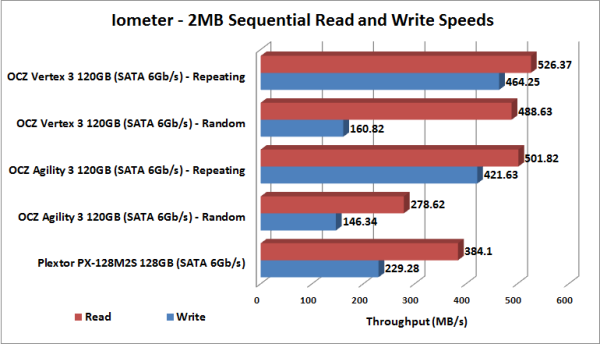
The Vertex 3's performance was very similar to what we saw in our other tests. With highly compressible, repeating data, the drive was able to read at 526.37 MB/s and write at 464.25 MB/s. The Vertex 3 did not slow nearly as much as the Agility 3 when reading random data. However, its write speeds dropped to 160.82 MB/s.
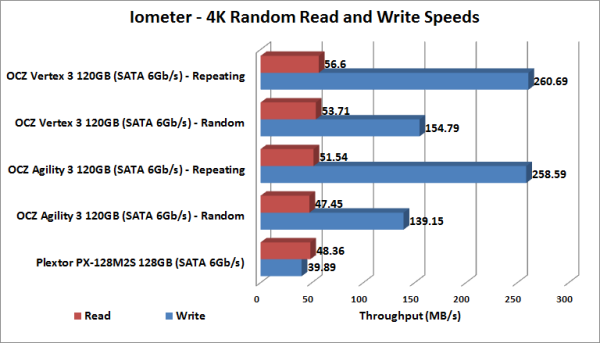
The Vertex 3 performed very well when doing random reads and writes. With repeating data, the drive was able to read at 56.6 MB/s and write at a blazing 260.69 MB/s. Here too, the Vertex 3 took a performance hit when tested with random data. However, it was still able to write at 154.79 MB/s.
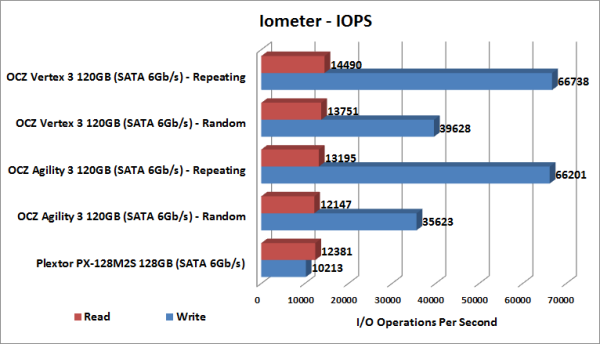
According to OCZ, the Vertex 3 is capable of 60,000 IOPS when randomly writing 4K blocks. In our tests, the drive reached 66,738 IOPS with repeating data and 39,628 IOPS with random data.
TRIM Performance:
While SSDs offer many benefits, there are some downsides to using flash memory. One of the biggest issues people run into is performance degradation. Over time, an SSD will run out of fresh blocks and will have to write over data the file system has marked as deleted. This procedure is very complicated and can slow an SSD's write speeds considerably.
To address this problem, most manufacturers have added TRIM support to their SSDs. The TRIM command allows an operating system, such as Windows 7, to tell an SSD which data blocks are no longer in use. Using this information, the drive pro-actively erases these blocks and adds them to the free block pool.
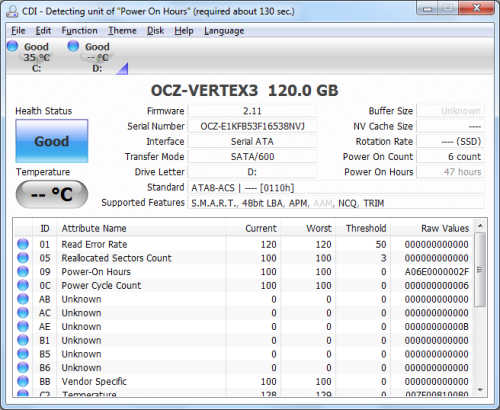
To test the Vertex 3's TRIM function, I first put the drive in a "dirty" state. I used Iometer to fill the entire drive and then ran a random write test for 20 minutes. Surprisingly, this had very little effect on the Vertex 3's write speed. However, its average read speed dropped to 206.2 MB/s.
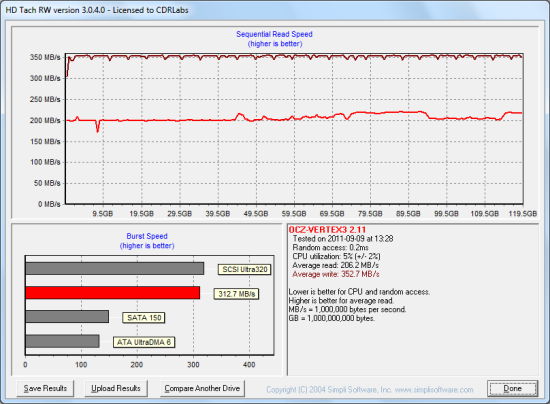
OCZ Vertex 3 - Dirty
To see how well the Vertex 3 could recover, I let the computer sit for a few hours and then reran the test. The drive wasn't able to reach the factory fresh performance shown in our earlier tests, as its average read speed climbed up to 291.4 MB/s.
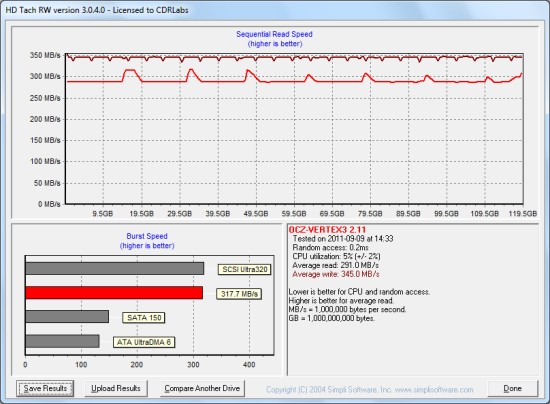
OCZ Vertex 3 - After Trim
Lastly, I used OCZ's Toolbox utility to perform a secure erase on the Vertex 3. With the drive wiped clean, its read speed jumped back up to 363.0 MB/s.
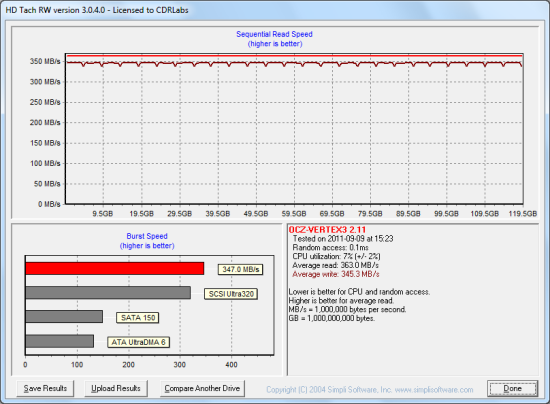
OCZ Vertex 3 - Wiped
Final Thoughts:
OCZ's 120GB Vertex 3 is an excellent choice for anyone looking to put a high-performance SSD in their desktop or laptop. Thanks to its SandForce SF-2281 controller and SATA 6Gb/s interface, the drive performed very well in our sequential read and write tests, reading at speeds as high as 558 MB/s and writing at speeds in excess of 460 MB/s. The Vertex 3 also took the top spot in our random write tests, delivering more than 66,000 IOPS. As with other SandForce drives, the Vertex 3's performance did take a hit when reading and writing incompressible data. However, with its synchronous NAND flash, it was still faster than its sibling, the Agility 3.
The price of the 120GB Vertex 3 has come down considerably since it was introduced. It currently goes for $200 on Amazon.com, which is only $35 more than the Agility 3. With a price gap this small, the 120GB Vertex 3 is definitely the better bang for your buck. The price of the 240GB Vertex 3 has also come down some over the last few months. However, with prices starting at $460, it is still at least $100 more than the 240GB Agility 3. This may push more budget conscious consumers towards the Agility 3, but if you have the room in your computer, a pair of 120GB Vertex 3's would probably be a better choice.

Highs:
- Available in 60GB, 120GB and 240GB capacities
- Excellent sequential read and write speeds
- SATA 6Gb/s interface
- Synchronous NAND flash
- Supports TRIM, SMART and NCQ
- Includes a 2.5" to 3.5" adapter bracket
- 3 year warranty
- 60GB and 120GB versions are reasonably priced
Lows:
- Not as fast when writing incompressible data
- 240GB version is still pricey
